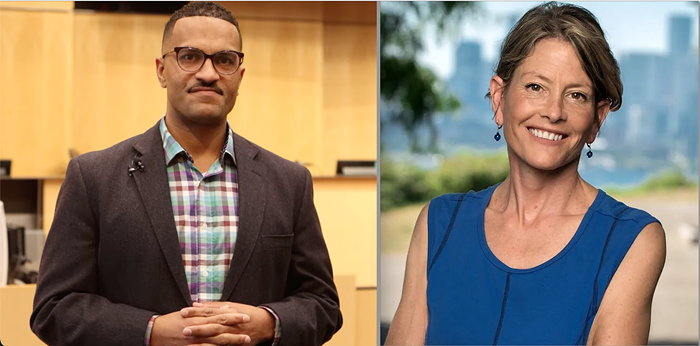I hold the restroom door closed while Pat Blank pretends to use the urinal. He unzips his fly, untangles his penis, and presents his 61-year-old circumcision scar and the new foreskin he's stretched for himself.
Let me back up.
Blank befriended me at the Ninth International Symposium on Circumcision, Genital Integrity, and Human Rights. Part academic conference, part anticircumcision rally, this year's symposium is in Seattle, running August 24–26, home to the national organization Doctors Opposing Circumcision.
DOC's executive director is local attorney John Geisheker. He's busted his balls bringing the event to the University of Washington. He had help from Marilyn Milos, who 20 years ago started the National Organization of Circumcision Information Resource Centers (NOCIRC), which has copresented all nine symposiums. At the first one in Anaheim, they laid out the principles of "intactivism," primarily: "...the inherent right of all human beings to an intact body... the foreskin, clitoris, and labia are normal, functional body parts... anyone practicing genital mutilation is violating Article V of the United Nations Universal Declaration of Human Rights... [against torture and cruel and inhuman treatment]."
The International AIDS Conference was held a week earlier in Toronto, where Bill Clinton voiced support for controversial HIV research involving circumcision. The report claimed that men with foreskins are 60 percent more likely to contract HIV than circumcised men. In reaction, a petition is circulating around the symposium entreating the Bill & Melinda Gates Foundation to pursue a vaccine instead of "embroiling Third World citizens as test subjects in a giant experiment that has already proved a failure in the U.S."
Between 55 and 65 percent of American males are circumcised, depending on who's counting. Most First World countries (i.e., Europe) circumcise less than 5 percent of their boys. Yet, according to UNAIDS statistics, our HIV adult-prevalence rate is double that of Western Europe. The "correlation" buoys the intactivists.
The intactivists also like to point out that while the American Association of Pediatricians says circumcision may protect against urinary-tract infections and penile cancer, the benefits aren't strong enough to recommend it be routinely performed on infants. A 2000 "trade-off analysis" conducted by UW researchers reported that for every circumcision complication in Washington, only six boys avoided urinary-tract infections. For every two complications, only one case of penile cancer was prevented.
The auditorium at UW's Johnson Hall, with around 120 attendees, roars whenever a speaker cites these facts and calls for an end to genital mutilation. The lobby is filled with books, videos, T-shirts, and "Not circumcised? Lucky stiff!" bumper stickers. There are more than 40 presentations, including anthropological data, gruesome medical reports, legislative and judicial updates, stories of desperation and inspiration, and a musical lament for the foreskin by local songwriter Jess Grant: "Every time I go to the bathroom to take a pee/I'm holding the evidence of what they did to me...."
Many of the attendees are males, or mothers of males, who were damaged physically and psychologically by circumcision. They claim they won't surrender while boys are still being subjected to the same trauma.
"One of the deepest instincts we have is to protect our reproductive organs. If someone did it to you right now, you'd hunt the bastard down," says William Stowell, the first American adult male to sue a doctor over neonatal (newborn) circumcision. He's counseling Arthur Benning, a 19-year-old student at UW who's contemplating a similar lawsuit. "That was my mindset. It's not anymore."
I ask whether Benning's circumcision was "medically successful" or "botched." "Is there a circumcision that isn't botched?," he replies. "I'm a runner and it hurts like hell. It's not comfortable, a lot of problems came from it. So, no, I don't think there is such a thing as a medically successful circumcision."
Pat Blank—whose involvement in the campaign dates back to NOCIRC's inception in San Francisco in 1986—is a small, talkative man with a turquoise headband, sandals, and a flair for dick puns. He estimates he's been with more than 6,000 men. (Throughout the '70s he was a callboy, but with the '80s' AIDS crisis he became a professional masseur, giving deep rubs and handjobs.) This weekend, he becomes my fixer, pointing out the circumcision-opposing Jews mingling around the tables in the lobby. He scores me a DVD of the circumcision-debunking episode of Penn & Teller's Bullshit! He introduces me to one of the first doctors to oppose circumcision, Dr. Paul Fleiss, "pediatrician to the stars" and father of Hollywood madam Heidi Fleiss.
On Friday, Blank points out Dr. Paul Tinari, an intactivist celebrity and last-minute presenter: At age 8, priests at Tinari's boarding school circumcised him as punishment for masturbating. Earlier this year, Tinari became the first Canadian to have his provincial health service pay for foreskin-replacement surgery.
I follow Tinari to a basement classroom where 17 gray-haired doctors are gathered for box lunches and a strategy discussion. Tall, gaunt, and furious, Tinari hijacks the meeting just as Geisheker, the Seattle-based attorney who heads DOC, has begun detailing the budget, labor, and membership shortfalls facing the organization.
"Everyone I hear are waving their arms and saying we don't have a stick big enough to hit back at this issue," Tinari announces. "I've come to the conclusion, after years of studying, that no appeal to morality will ever end circumcision. You have to make it so financially painful that it ends by punishing practitioners. How do you do that? I may have the tool that we've been looking for."
Tinari's big stick is "nanobacteria," a slowly replicating pathogen that is transmitted in the same ways as HIV. In a letter to the Centers for Disease Control and Prevention, Tinari links nanobacteria to everything from Alzheimer's disease to breast cancer and claims nanobacteria enter the body through neonatal circumcision. Thus, the door is open for lawsuits against doctors and hospitals.
Tinari's fiery-eyed delivery energizes some doctors, especially the delegation from England. Others, including Dr. Fleiss, are skeptical. Tinari's doctorate is in engineering, not medicine. In Canada, he's "Dr. Future," a futurist who once told the Vancouver Courier that cyborg insects will one day be used for military reconnaissance.
Geisheker tells Tinari he doubts the plan's feasibility, considering the prohibitive legal costs. Geisheker has funded several cases out of his own pocket. "I find it weird," he tells me later. "I'm perfectly open to the idea, but I need to see the science before I run it up the flagpole."
Later, Tinari contributes his strategy for combating Islamic circumcision: "You casually say 'show me the verse in the Koran which calls for circumcision.' There is none. Then you can really hit them: 'Well I guess you want your kids to look Jewish.'" The doctors burst into hysterical laughter. Especially the Jewish ones.
I sneak off to bum a clove cigarette from Primus Lake, an Indonesian STD researcher whose stumbling English keeps him from mingling. As we talk and smoke, he presents a conundrum.
Imagine you're out in the Indonesian drylands, educating non-Muslim men about the dangers of their adult-circumcision ritual, which requires them to screw three women to purify their open circumcision wounds. They already believe the rite makes them impervious to disease. Now, imagine that globally recognized authority figure Bill Clinton announces that circumcision can prevent AIDS.
"It will be a disaster," says Lake, who attended the Toronto conference. "Logically, [HIV transmission] is connected to our behavior. If you're having risky sex and don't use a condom, although you are circumcised, you are still at risk. "I told them, 'we can help people do it the right way, but don't promote it!'"
In addition to pointing me to the experts, it turns out Blank is a bit of an expert himself. More than 75 percent of his clients, he says, are circumcised men. But his incredible breadth of cock knowledge isn't conventional enough for public presentation. Blank drags me to the restroom to illustrate "tugging," the application of constant pressure to the skin behind the head of the penis. (This is how I first ended up in the stall looking at Blank's penis.)
"The severely circumcised male cannot be gotten off with just the tightness of my fist. He has to have his nipples pinched, he has to have to his balls pulled on, he has to be finger-fucked."
Blank says people need to understand the purpose of the foreskin: glans preservation, sexual lubrication, and additional nerve endings. Even smegma—the accumulated gunk that circumcision aims to prevent—has a purpose. "For all the stink and cheese, that smell is there for two reasons: to attract and to repel," Blank says. "The genitals are the flowers of our body. When the petals are removed, the fragrance dissipates. That fragrance, our individual stamp, is what is ripped out of our sexual experience when you're circumcised."
It looks like a toothless mouth sucking an apricot. As he retracts the pseudo-foreskin, I see the head is pale and moist. "I've regained 25 percent of the sensitivity," he brags—then stuffs it away.

















